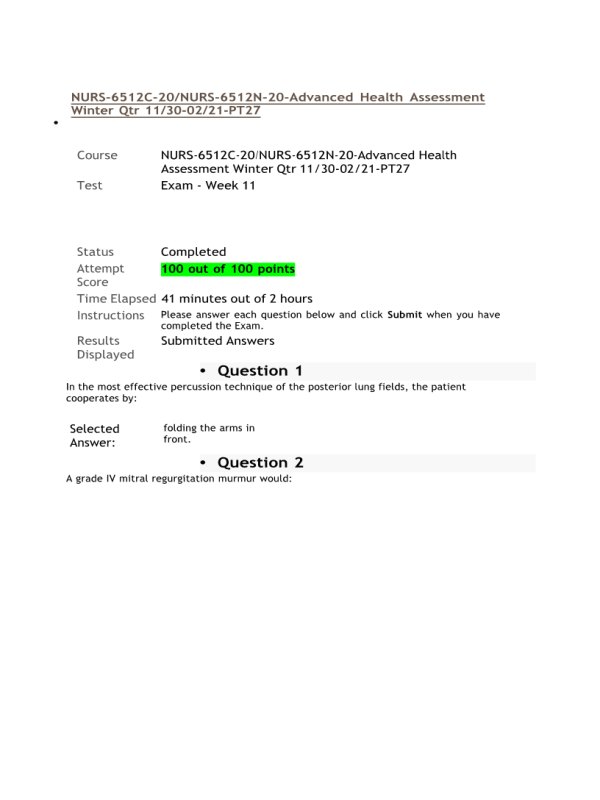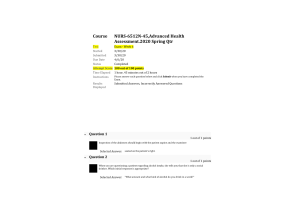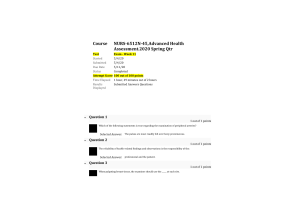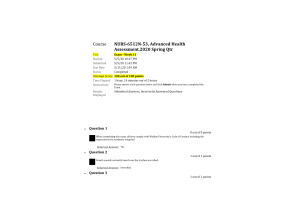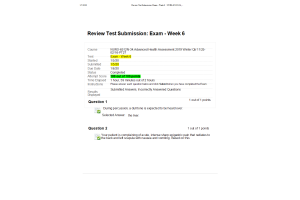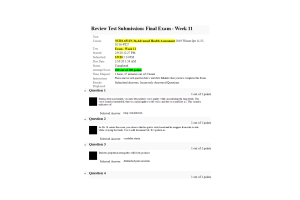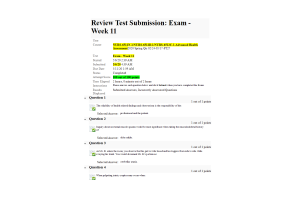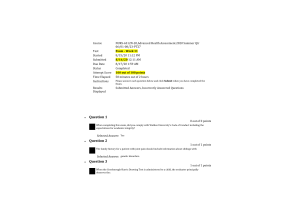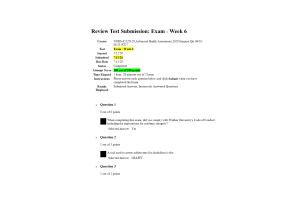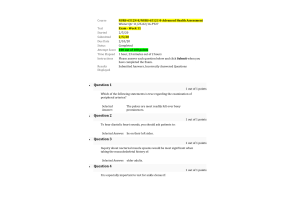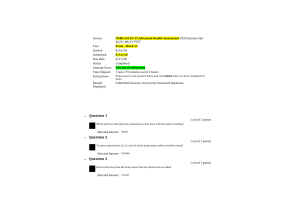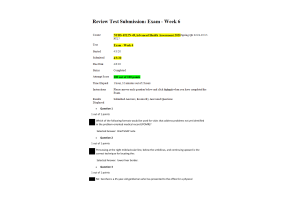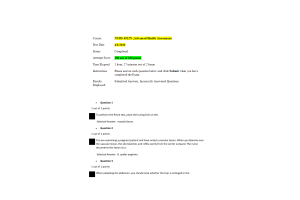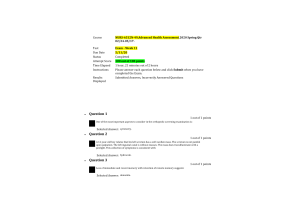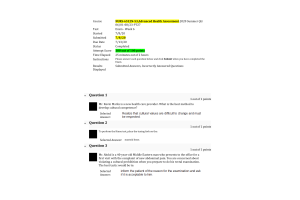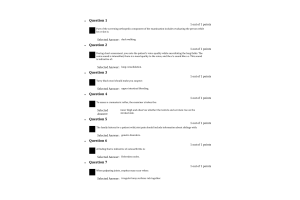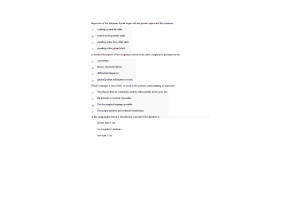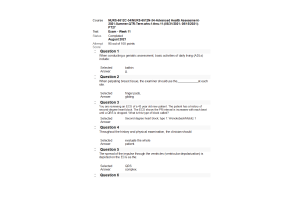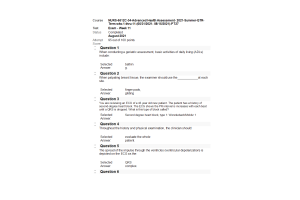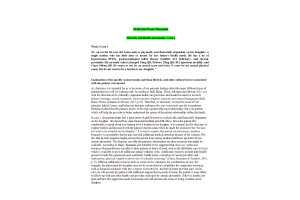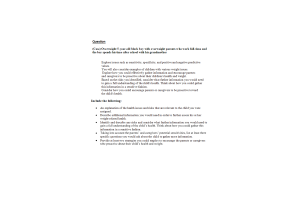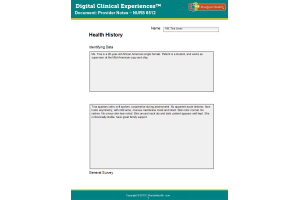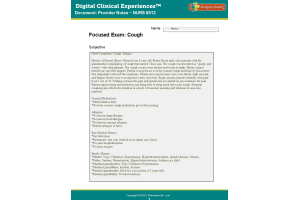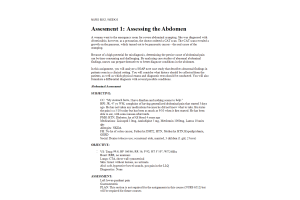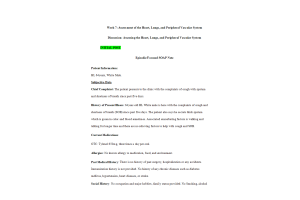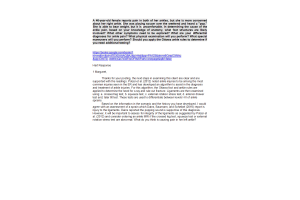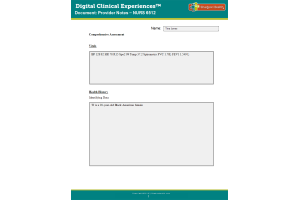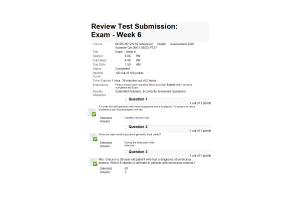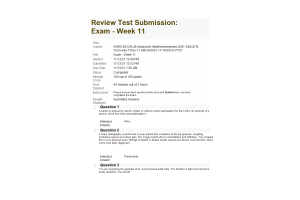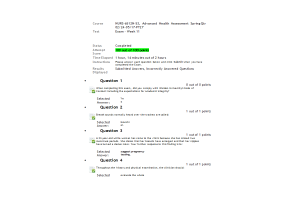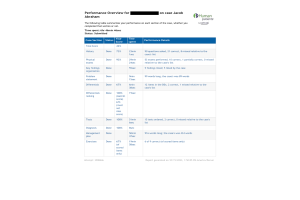NURS 6512C-20, NURS-6512N-20 Week 11 Final Exam (100 out of 100 Points)
- $59.00
- Question: In the most effective percussion technique of the posterior lung fields, the patient cooperates by:
- Question: A grade IV mitral regurgitation murmur would:
- Question: Which condition is considered progressive rather than reversible?
- Question: Darian is a 14-year-old adolescent who states his right testicle has a soft swollen mass. The testicle is not painful upon palpation. The right inguinal canal is without masses. The mass does transilluminate with a penlight. This collection of symptoms is consistent with:
- Question: A red, hot swollen joint in a 40-year-old man should lead you to suspect:
- Question: When conducting a geriatric assessment, basic activities of daily living (ADLs) include:
- Question: You are examining a patient in the emergency department who has recently sustained head trauma. In order to initially assess this patient's neurologic status, you would:
- Question: You are inspecting the genitalia of an uncircumcised adult male. The foreskin is tight and cannot be easily retracted. You should:
- Question: When palpating joints, crepitus may occur when:
- Question: Palpation of epitrochlear nodes is part of the:
- Question: A cervical polyp usually appears as a:
- Question: Which of the following statements is true regarding the examination of peripheral arteries?
- Question: It is especially important to test for ankle clonus if:
- Question: Ulnar deviation and boutonniere deformities are characteristic of:
- Question: Normal changes of the aging brain include:
- Question: Your patient's chief complaint is repeated pencil-like stools. Further examination should include:
- Question: Which one of the following techniques is used to detect a torn meniscus?
- Question: Bimanual examination of the uterus includes:
- Question: The spread of the impulse through the ventricles (ventricular depolarization) is depicted on the ECG as the:
- Question: Part of the screening orthopedic component of the examination includes evaluating the person while he or she is:
- Question: An ophthalmoscopic eye examination involves:
- Question: Which cranial nerves are usually evaluated during the examination of the eyes?
- Question: Which portion of the physical examination is best done with the patient standing?
- Question: When assessing superficial pain, touch, vibration, and position perceptions, you are testing:
- Question: An examiner has rotated a brush several times into the cervical os. The brush was withdrawn and stroked lightly on a glass slide. The slide was sprayed with fixative. Which type of specimen requires this technique for collection?
- Question: Functional assessment is most important during the examination of a(n):
- Question: Which one of the following is a proper technique for use of a speculum during a vaginal examination?
- Question: If your patient has nipple discharge, you will most likely need a:
- Question: You are initially evaluating the equilibrium of Ms. Q. You ask her to stand with her feet together and arms at her sides. She loses her balance. Ms. Q. has a positive:
- Question: Examination of the patient in the lithotomy, or knee-chest, position includes:
- Question: An idiopathic spasm of arterioles in the digits is termed:
- Question: To assess a cremasteric reflex, the examiner strokes the:
- Question: A 25 yo AA female has come to the clinic because she has missed her menstrual period this month and 2 months before. She says her cycles are irregular and she wants to be on birth control to help regulate them. She states that her breasts have enlarged and that her nipples have turned a darker color. Your further response to this finding is to:
- Question: You are conducting an examination of Mr. Curtis's heart and blood vessels and auscultate a grade III murmur. The intensity of this murmur is:
- Question: The physical assessment technique most frequently used to assess joint symmetry is:
- Question: At your first meeting with a patient, it is usually best to say:
- Question: The finger-to-nose test allows assessment of:
- Question: While examining a 30-year-old woman, you note that one breast is slightly larger than the other. In response to this finding, you should:
- Question: A parent is advised to restrict contact or collision sports participation for their child. An example of a sport in which this child could participate is:
- Question: You are examining Mr. S., a 79-year-old diabetic man complaining of claudication. Which of the following physical findings is consistent with the diagnosis of arterial occlusion?
- Question: The family history for a patient with joint pain should include information about siblings with:
- Question: The difference in blood pressure readings between the right and the left arms is considered normal up to mm Hg
- Question: To assess spinal levels L2, L3, and L4, which deep tendon reflex should be tested?
- Question: To hear diastolic heart sounds, you should ask patients to:
- Question: The strength of the trapezius muscle is evaluated by having the patient:
- Question: The Mini-Mental State Examination:
- Question: If a patient cannot shrug the shoulders against resistance, which cranial nerve (CN) requires further evaluation?
- Question: Anterior cruciate ligament integrity is assessed via the test.
- Question: Postural hypotension is defined as a when the patient stands, compared with sitting or supine readings.
- Question: Loss of immediate and recent memory with retention of remote memory suggests:
- Question: A positive straight leg raise test usually indicates:
- Question: Kawasaki disease is suspected when assessments of a child reveal:
- Question: Temporalis and masseter muscles are evaluated by:
- Question: For purposes of examination and communication of physical findings, the breast is divided into:
- Question: The best way to ease the apprehension of a 3-year-old child before a physical examination is to:
- Question: The adnexa of the uterus are composed of the:
- Question: Cranial nerve XII may be assessed in an infant by:
- Question: During a routine prenatal visit, Ms. T. was noted as having dependent edema, varicosities of the legs, and hemorrhoids. She expressed concern about these symptoms. You explain to Ms. T. that her enlarged uterus is compressing her pelvic veins and her inferior vena cava. You would further explain that these findings:
- Question: ou are conducting a clinical breast examination for your 30-year-old patient. Her breasts are symmetrical with bilateral, multiple tender masses that are freely moveable with well-defined borders. You recognize that these symptoms and assessment findings are
- Question: Which medical condition would exclude a person from sports participation?
- Question: Electrical activity recorded by the electrocardiogram (ECG) tracing that denotes the spread of the stimulus through the atria is the:
- Question: An apical PMI palpated beyond the left fifth intercostal space may indicate:
- Question: When assessing a 17-year-old for nuchal rigidity, you gently raise his head off the examination table. He involuntarily flexes his hips and knees. To confirm your suspicions associated with this positive test, you would also perform a test for the sign.
- Question: Breath sounds normally heard over the trachea are called:
- Question: Throughout the history and physical examination, the clinician should:
- Question: Recent unilateral inversion of a previously everted nipple suggests:
- Question: The examiner percusses for diaphragmatic excursion along the:
- Question: To spread the breast tissue evenly over the chest wall, you should ask the woman to lie supine with:
- Question: Nerves that arise from the brain rather than the spinal cord are called:
- Question: You are assessing Mr. Z.'s fluid volume status as a result of heart failure. If your finger depresses a patient's edematous ankle to a depth of 6 mm, you should record this pitting as:
- Question: A common finding in markedly obese and pregnant women is:
- Question: Assessing orientation to person, place, and time helps determine:
- Question: The rectal past medical history of all patients should include inquiry about:
- Question: The foramen ovale should close:
- Question: During chest assessment, you note the patient's voice quality while auscultating the lung fields. The voice sound is intensified, there is a nasal quality to the voice, and the e's sound like a s. This sound is indicative of:
- Question: Inquiry about nocturnal muscle spasms would be most significant when taking the musculoskeletal history of:
- Question: The Mini-Mental State Examination should be administered for the patient who:
- Question: While collecting personal and social history data from a woman complaining of breast discomfort, you should question her regarding:
- Question: Adrian Thompson is a 19-year-old girl who presents to the clinic with complaints of severe, acute chest pain. Her mother reports that Andrian, apart from occasional sinus infections, Andrian is not prone to respiratory problems. What potential risk factor is most important to assess with regards to Adrian's current problem?
- Question: Tarry black stool should make you suspect:
- Question: You are interviewing a 20-year-old patient with a new-onset psychotic disorder. The patient is apathetic and has disturbed thoughts and language patterns. The nurse recognizes this behavior pattern as consistent with a diagnosis of:
- Question: The Denver II is a tool used to determine:
- Question: The reliability of health-related findings and observations is the responsibility of the:
- Question: As Mr. B. enters the room, you observe that his gait is wide based and he staggers from side to side while swaying his trunk. You would document Mr. B.'s pattern as:
- Question: A patient you are seeing in the emergency department for chest pain is suspected of having a myocardial infarction. During the health history interview of his family history, he relates that his father had died of "heart trouble." The most important follow-up question you should pose is which of the following?
- Question: Your older clinic patient is being seen today as a follow-up for a 2-day history of pneumonia. The patient continues to have a productive cough, shortness of breath, and lethargy and has been spending most of the day lying in bed. You should begin the chest examination by:
- Question: In the adult, the apical impulse should be most visible when the patient is in what position?
- Question: You are performing a two-point discrimination test as part of a well physical examination. The area with the ability to discern two points in the shortest distance is the:
- Question: Inspection of the scrotum should reveal:
- Question: A finding that is indicative of osteoarthritis is:
- Question: Palpation of a normal prostate in an older adult is likely to feel:
- Question: The presence of cervical motion tenderness may indicate:
- Question: A patient in the deepest coma would be scored a on the Glasgow Coma Scale.
- Question: Facial muscle or tongue weakness may result in:
- Question: When is the mental status portion of the neurologic system examination performed?
- Question: The goals of preparticipation sports evaluation include:
- Question: One of the most important aspects to consider in the orthopedic screening examination
- Question: When palpating breast tissue, the examiner should use the at each site.
- Question: You are conducting a preparticipation physical examination for a 10-year-old girl with Down syndrome who will be playing basketball. She has slight torticollis and mild ankle clonus. What additional diagnostic testing would be required for her?
- Question: Diabetic peripheral neuropathy will likely produce:
- Question: When completing this exam, did you comply with Walden University's Code of Conduct including the expectations for academic integrity?
